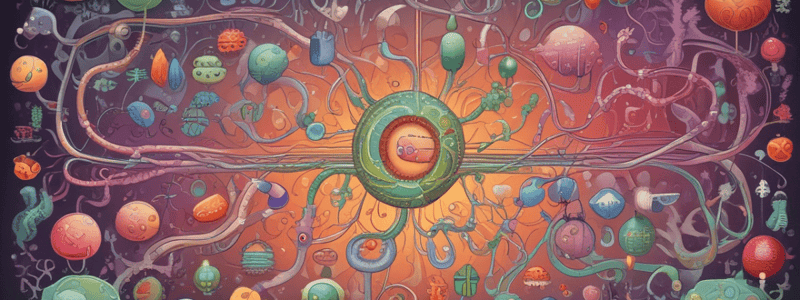Podcast
Questions and Answers
What is the result of the breakdown of glucose during cellular respiration?
What is the result of the breakdown of glucose during cellular respiration?
- Oxygen is oxidised to carbon dioxide
- Glucose is reduced to carbon
- Carbon dioxide is reduced to glucose
- Glucose is oxidised to carbon (correct)
What is the role of other energy carriers in cellular respiration?
What is the role of other energy carriers in cellular respiration?
- To synthesise hormones and cell membranes
- To generate ATP directly from glucose
- To reduce oxygen to water
- To capture energy before ATP is generated (correct)
What is the primary function of ATP in cellular respiration?
What is the primary function of ATP in cellular respiration?
- To facilitate energy transfer between chemical reactions (correct)
- To synthesize glucose from glycogen
- To store energy for long periods of time
- To break down proteins into peptides
What is the result of oxidation during cellular respiration?
What is the result of oxidation during cellular respiration?
What is the equation for the breakdown of glucose during cellular respiration?
What is the equation for the breakdown of glucose during cellular respiration?
What is the difference between anabolism and catabolism?
What is the difference between anabolism and catabolism?
What is an example of active transport that uses energy from cellular respiration?
What is an example of active transport that uses energy from cellular respiration?
What is the process of breaking down glucose to release energy?
What is the process of breaking down glucose to release energy?
What is the byproduct of glucose catabolism in cellular respiration?
What is the byproduct of glucose catabolism in cellular respiration?
What is the reduced molecule during the breakdown of glucose in cellular respiration?
What is the reduced molecule during the breakdown of glucose in cellular respiration?
What is the function of the Electron Transport Chain in cellular respiration?
What is the function of the Electron Transport Chain in cellular respiration?
What is the term for the collection of all chemical reactions that occur in the body?
What is the term for the collection of all chemical reactions that occur in the body?
What is the energy currency of the cell?
What is the energy currency of the cell?
How often is the ATP in a cell turned over?
How often is the ATP in a cell turned over?
What is the byproduct of protein breakdown in cellular respiration?
What is the byproduct of protein breakdown in cellular respiration?
What is the term for the breakdown of glucose in the absence of oxygen?
What is the term for the breakdown of glucose in the absence of oxygen?
What is the role of NAD+ in cellular respiration?
What is the role of NAD+ in cellular respiration?
Which reaction occurs in the cytoplasm and does not require oxygen?
Which reaction occurs in the cytoplasm and does not require oxygen?
What is the net ATP produced in glycolysis?
What is the net ATP produced in glycolysis?
What is the product of the intermediate reaction?
What is the product of the intermediate reaction?
How many ATP molecules are produced per glucose molecule in the electron transport chain?
How many ATP molecules are produced per glucose molecule in the electron transport chain?
What is the role of FADH2 in the electron transport chain?
What is the role of FADH2 in the electron transport chain?
What is the byproduct of the electron transport chain?
What is the byproduct of the electron transport chain?
What is the advantage of aerobic pathways over anaerobic pathways?
What is the advantage of aerobic pathways over anaerobic pathways?
What is the role of ATP synthase in the electron transport chain?
What is the role of ATP synthase in the electron transport chain?
What would be the effect of consuming a poison that inhibits ATP synthase?
What would be the effect of consuming a poison that inhibits ATP synthase?
Study Notes
Cellular Respiration
- Cellular respiration: the process of generating energy for the cell through the breakdown of glucose and other molecules
- Involves many oxidation-reduction reactions, including the breakdown of glucose to CO2 and H2O
Energy Carriers
- ATP (Adenosine Triphosphate): the energy currency of the cell, holding energy temporarily in covalent bonds between phosphates
- ATP is generated in the presence (aerobic respiration) or absence (anaerobic respiration) of oxygen
- ~1 billion ATP molecules are in a cell at any one time, turned over every 1-2 minutes
- At rest, we produce our body weight in ATP every day; at maximal exercise, this number can increase to 0.5-1kg per minute
Anabolism and Catabolism
- Anabolism: the process of building molecules, such as the synthesis of glycogen from glucose
- Catabolism: the process of breaking down molecules, such as the breakdown of proteins to peptides
- Energy can be extracted from the breakdown of carbohydrates, proteins, and lipids
Cellular Respiration Pathways
- Glycolysis: a series of 10 reactions in the cytosol that produces 2 pyruvate molecules from 1 glucose molecule, producing 4 ATP molecules (net 2 ATP)
- Intermediate reaction: the process of pyruvate converting to Acetyl CoA, producing NADH and CO2
- Krebs Cycle: a series of 8 reactions in the mitochondrial matrix, producing 2 CO2, 3 NADH, one FADH2, and one ATP
- Electron Transport Chain: the process of electrons donated by NADH and FADH2 moving through protein complexes, generating ATP through the pumping of H+ and the formation of water
ATP Synthesis
- ATP synthase harnesses potential energy to generate ATP by combining ADP and Pi
- H+ are concentrated in the intermembrane space, creating an electrochemical gradient
- Energy is harvested from the flow of H+ down their electrochemical gradient through ATP synthase
Aerobic and Anaerobic Respiration
- Aerobic pathways: more efficient at producing ATP, producing 28-34 ATP molecules per glucose molecule
- Anaerobic pathways: less efficient, producing 2 ATP molecules per glucose molecule
- Glycolysis is faster but only produces net 2 ATP per glucose molecule, while the electron transport chain takes longer but produces 28-34 ATP molecules per glucose molecule
Studying That Suits You
Use AI to generate personalized quizzes and flashcards to suit your learning preferences.



